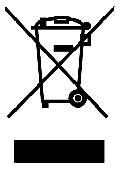Agilent and the WEEE Directive
Background
 The European Union's (EU) Waste Electrical and Electronic Equipment (WEEE) Directive was implemented in Member States during 2005-2006. The aim of the Directive is to halt the growing volume of electrical and electronic waste disposed of in landfill sites, by making manufacturers responsible for financing environmentally safe disposal of end-of-life equipment through recycling.
The European Union's (EU) Waste Electrical and Electronic Equipment (WEEE) Directive was implemented in Member States during 2005-2006. The aim of the Directive is to halt the growing volume of electrical and electronic waste disposed of in landfill sites, by making manufacturers responsible for financing environmentally safe disposal of end-of-life equipment through recycling.
The Directive treats domestic and business-to-business (B2B) waste differently. According to the Directive, households are able to hand-over waste equipment free of charge at retailers or municipal collection points. However with regards to B2B customers, the Directive requires manufacturers only to take back equipment sold after 13 August 2005, or older equipment if customer buys a replacement.
The Directive covers most electronic and electrical products from office equipment to household appliances like TVs, tumble dryers and power tools. The types of electronic equipment involved are divided into ten different categories and Agilent's end-user products fall within category nine called "Monitoring and Control" equipment.
How does this affect Agilent and its customers?
Agilent is working with compliance schemes and/or service providers which implement effective take-back of products in different Member State countries. Detailed information is available on the country pages (available under "Take-back instructions")
Agilent and WEEE Compliance
Agilent has registered in Member States according to WEEE legislation requirements. Agilent will supply product information to treatment facility operators as needed to separate any hazardous parts before recycling.
As required by the legislation, products sold in the EU are marked with the "crossed out wheelie bin" symbol. Agilent uses the symbol based on the EN 50419:2005 CENELEC standard. The bottom bar certifies the product concerned was placed on the market after 13th August 2005. Cables or components and sub-assemblies contained within a product typically will not be marked.